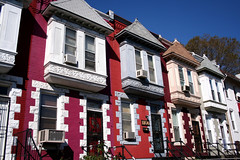"What Style is it?" Preservation Cafe tonight (Capitol Hill Restoration Society--DC)
 Brick and frame rowhouses on Capitol Hill. Photo from BeyondDC.
Brick and frame rowhouses on Capitol Hill. Photo from BeyondDC.I have been remiss in posting about this.
What: Capitol Hill Home Styles--"What Style Is It?"/Hill architect Judith Capen
Where: Marty's Restaurant, 527 8th Street SE
When: Wednesday, February 15 at 6:30 p.m.
For more information, contact the Capitol Hill Restoration Society at 543-0425.
Capitol Hill is known as a "Victorian" neighborhood, but are all our houses "Victorian Style"?Indeed not, and Judith Capen, AIA, will give a powerpoint presentation at the February Preservation Cafe to help straighten out Capitol Hill's stylistic lexicon.
"What Style Is It?" will look not only at buildings of different styles but also at various elements of those buildings--the mansard roofs, Italianate cornices, and Craftsmen porches that help define those styles. Capitol Hill's buildings start in the late 1790s with the Federal and Georgian styles (or at least the row-house equivalents of those styles.) We have buildings influenced by the Greek Revival movement and others by the Italianate period. Towards the end of the 19th century building became even more diverse, with elements from Richardsonian Romanesque, Moorish Revival, Gothic Revival, Egyptian Revival, Renaissance Revival, and Queen Anne styles. All these and more were added into the mix--Stick Style, Beaux Arts Classicism, Georgian Revival, Tudor Revival, and finally Modernistic.
Judith Capen is the perfect guide: she is a long-time Capitol Hill resident, a restoration architect, teacher of architectural history classes, and author of Restoration Society's guideline, Building styles in the Capitol Hill Historic District.
________
I hear that CHRS is interested in expanding the historic district up to H Street NE. Would that leave the houses north of H Street to founder, with little in the way of protection and advocacy? How do they intend to handle the H Street commercial district? Just the south side? Both sides? Neither?
CHRS has always been supporting of historic preservation efforts north of the Capitol Hill Historic District, even to the point of providing some matching funds to nascent survey efforts a few years ago, paired with monies awarded by the DC Historic Preservation Office. In 2001 I think, CHRS through a vote of the membership, expanded their interest area to include the area north up to Florida Avenue NE.
I would hope that efforts to promote preservation and possible designation could continue beyond H Street...
See H Street Neighborhood Social and Cultural History for information about the overview study performed in 2001-2002, and this page on H Street DC for some photos.
 Rowhouses on the 1100 block of 8th Street NE (by Gallaudet University), Washington DC. Photo by Elise Bernard.
Rowhouses on the 1100 block of 8th Street NE (by Gallaudet University), Washington DC. Photo by Elise Bernard.Index Keywords: historic-preservation



0 Comments:
Post a Comment
<< Home